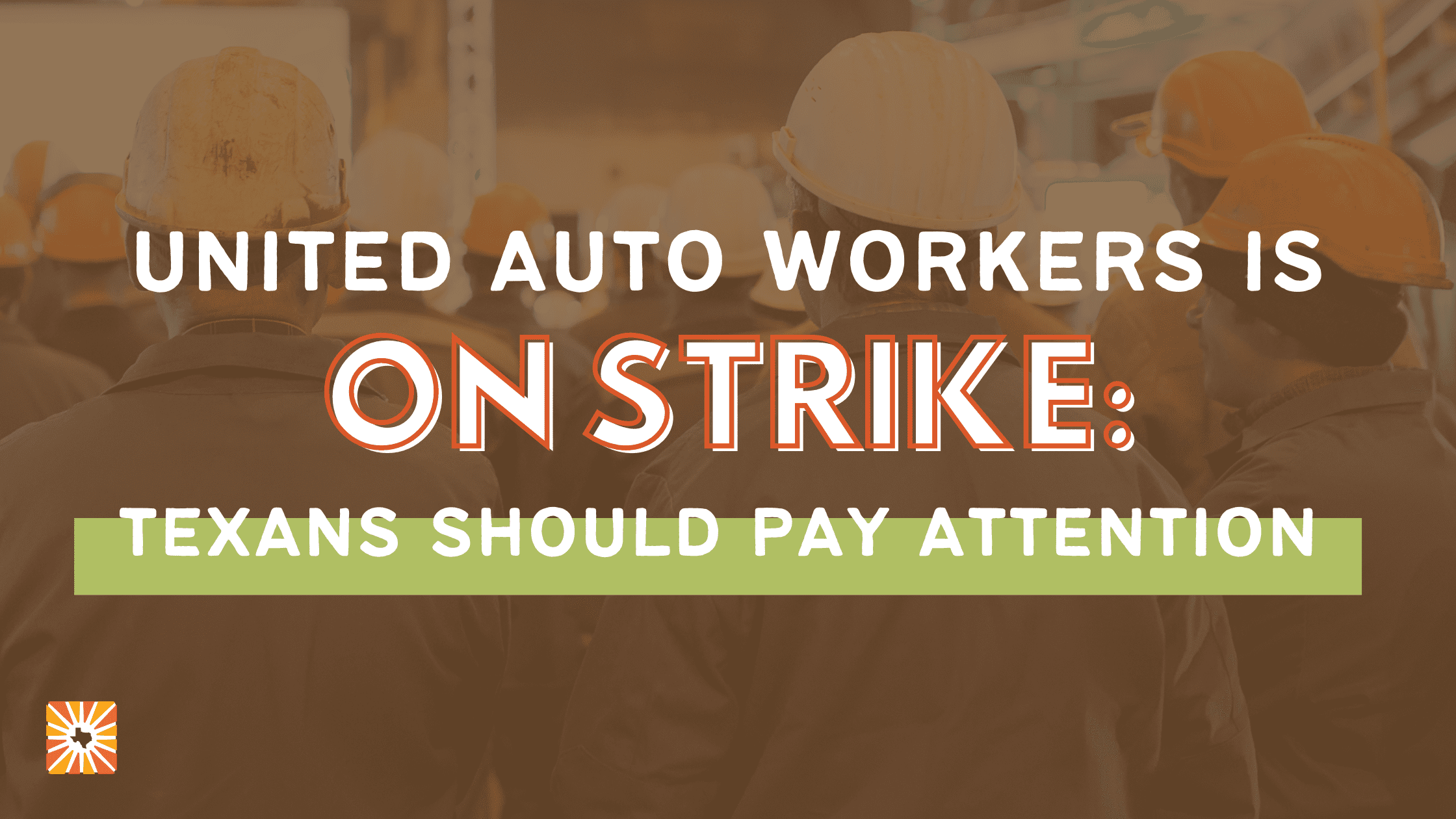We’ve seen the news; the United Auto Workers (UAW) union is on strike. But, what is a strike, why now, and what does it mean for Texans?
In September, UAW workers declared a strike against Ford, GM, and Stellantis (formerly Fiat Chrysler), also known as the Big 3, to demand better wages and a fair share in historic automaker profits. Strikes happen when workers feel they have no choice but to collectively withhold their labor from an employer to gain concessions during contract negotiations. Historically, workers of all backgrounds have used strikes to improve their wages, benefits, and working conditions.
From 2013 to 2022, CEO pay at Big 3 automakers increased by 40% while workers’ take-home wages declined. The Big 3 share record profits with their shareholders through “dividends and share buybacks,” but deliberately choose not to share profits with workers. The UAW strike is history in the making. It is an important time for Texans, regardless of where we live or what we look like, to understand how unions and workers’ collective actions build lasting, multiracial economic prosperity.
What’s a union?
A labor union is a group of two or more employees who join together to advance working conditions and common interests such as wages, benefits, schedules, and other employment terms.
By working through a labor union, employees can achieve higher wages, more affordable or no cost health insurance, vacation days, paid leaves, retirement, and other benefits reflecting the will of union members. For example, our staff union, Every Texan United, won a $200 monthly stipend to mitigate members’ student loan debt. Labor unions can also improve employees’ working conditions through fair scheduling, anti-harassment measures, and safety protections.
Federal law requires unions to maintain financial transparency and conduct fair elections for leadership and governance of the organization.
Union workers build prosperity for families of all backgrounds.
Unions increase income equality between the wealthiest few and working families.
- American workers have been fighting for better working conditions and a fair share in the prosperity their labor helps create since before the Revolutionary War. Data from the last 100 years show that as union membership increases, the share of income for the top 1% decreases, leading to a larger multiracial middle class.
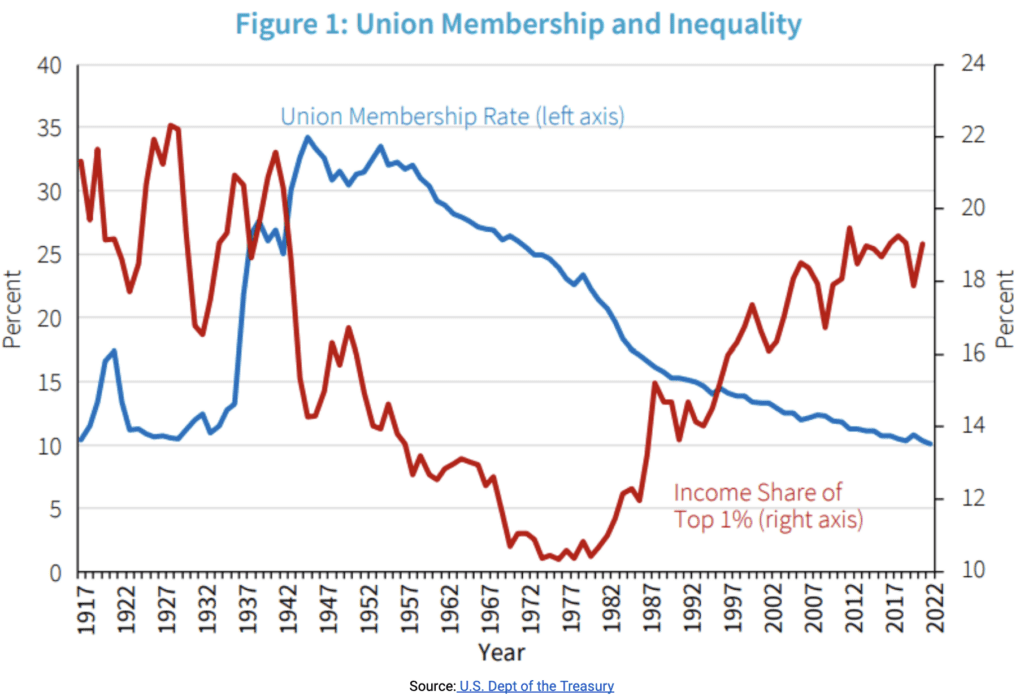
Today, U.S. workers once again experience a significant gap between their wages and the top 1% of highest income holders. According to research by the Economic Policy Institute (EPI), the gap between CEOs and typical workers’ salaries is widening rapidly.
Union workers experience more equitable pay.
- Women in unions earn 23% more than their non-unionized peers. Women covered by a union contract earn 87.3 cents for every dollar paid to union men compared to non-unionized women, who earn 82 cents for every dollar paid to non-unionized men.

- Similarly, Black union workers experience more equitable pay than non-union workers. While white families have a 7 to 1 wealth advantage against non-union Black families, this ratio is roughly half as large for Black families benefiting from a union contract. The median white family holds $3.70 in wealth for every $1 held by the median Black family benefitting from a union contract.
Union workers experience higher wages than non-union workers.
- In 2022, the Bureau of Labor Statistics reported that, on average, union workers earn $187 per week and $9,724 per year more than nonunion workers. Among full-time wage and salary workers, union members had median weekly earnings of $1,216 in 2022, while non-union workers had median weekly earnings of $1,029. There is also a union advantage for young workers; Between 2016 and 2021, the median hourly wage for a young union worker was $23.86 compared to $17.27 for a young non-union worker.
Texas has unions!
All workers have the right to join a union. You have probably heard that Texas is a right-to-work state, but unions are still legal and growing in Texas! Right-to-work is a policy backed by wealthy corporations to undermine working families’ economic and social advancement by limiting the effectiveness of organized labor. Right-to-work laws started in the 1940s, as Southern states worked to maintain Jim Crow-era segregation. Workers do not have to pay union membership dues in right-to-work states to receive the pay, benefits, and grievance procedures negotiated between the union and the employer. Conservative lawmakers championed these policies to discourage workers from paying membership dues and staying active in their union. Right-to-work states have lower wages, but unionized workers can make their voices heard with collective bargaining.
Collective bargaining is the process by which working people, through their unions, negotiate contracts with their employers to determine their terms of employment, including pay, benefits, hours, leave, health, and safety. Texas banned public sector workers from collective bargaining in 1947 but made an exception for police and firefighters. Even without collective bargaining, public sector unions raise the bar for workers’ pay, benefits, and working conditions through collective demands and actions.
Collective bargaining can solve workplace issues and ensure the most powerful people and institutions don’t disregard workers’ voices. We’ve talked before about how collective bargaining for teachers and an empowered education workforce can help prevent Gov. Abbott’s destruction of public education.
How many Texas workers are in a union? In 2022, union density in Texas, which is 4.1% percent of the state labor force, sat at the bottom five of U.S. states with the top two states, Hawaii and New York, having union density at 21.9% and 20.7%. The good news is Texas’ union membership increased from 3.8% in 2021, while still down from its 7.5% peak in 1993.
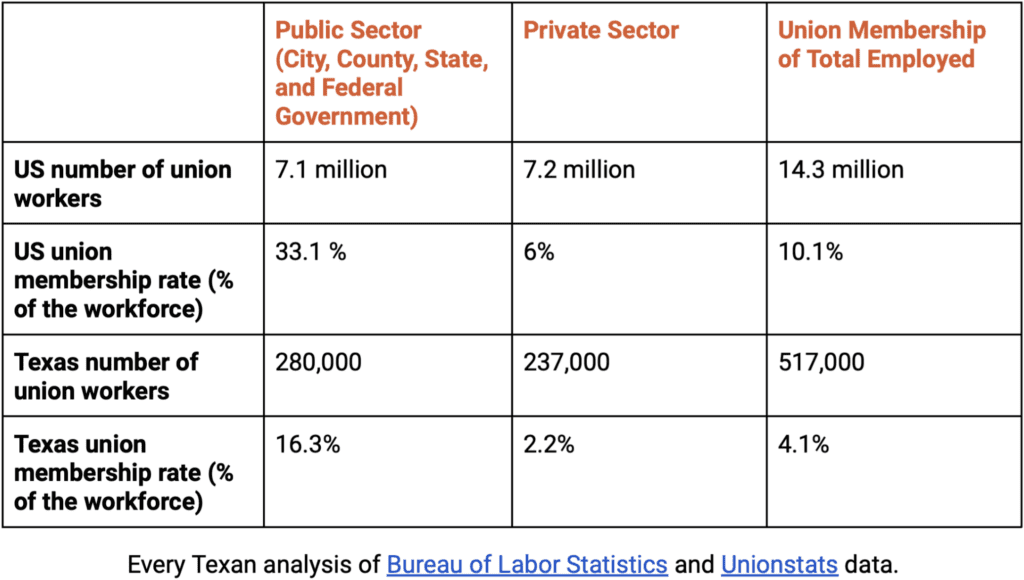
Americans approve of unions (especially GenZ).
American union approval reached a 60-year high in 2022 at 71%. (Gallup polling shows 68% for 2023). The highest American union approval occurred in 1953 at 75%, with actual union membership reaching 35%. This year, Gallup found that 3 in 4 Americans side with the United Auto Workers, and 77% say that unions mostly help rather than hurt union members.
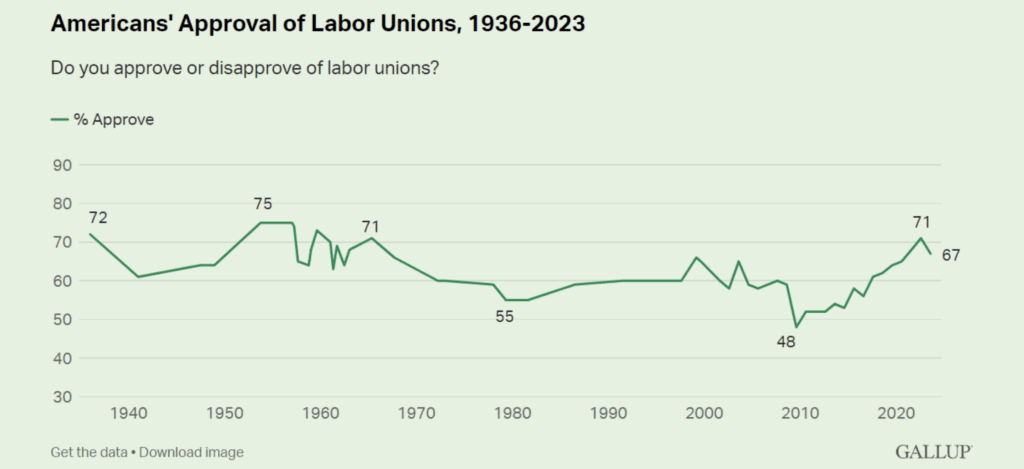
Young Americans entering the workforce favor unions at higher rates than older generations. In 2022, the Center for Economic and Policy Research found that union membership increased earnings for GenZ and Millennials. Today, younger workers are acutely aware of the systemic economic challenges they face and how unions can help address systemic inequities. Many GenZ workers may never own a home, be free from student loan debt, or earn the salaries that their predecessors did; GenZ recognizes that union membership means greater opportunity for economic security.

How Texans View Unions
More than 1 in 3 Texans view unions as very or somewhat favorable, while a quarter of Texans have neither a positive or negative view of unions. Overall, there are more Texans who favor unions or don’t know enough about unions to give an opinion than there are Texans opposed to unions.
- 30% of polled Texans communicated a somewhat or very unfavorable view of unions.
- 7% communicated they didn’t know or have no opinion.
- Similar to the national data, younger Texans, those under the age of 29 show substantially higher “very union favorable” rates than the older age groups, while Texans 65 years and older have the highest unfavorability rate.
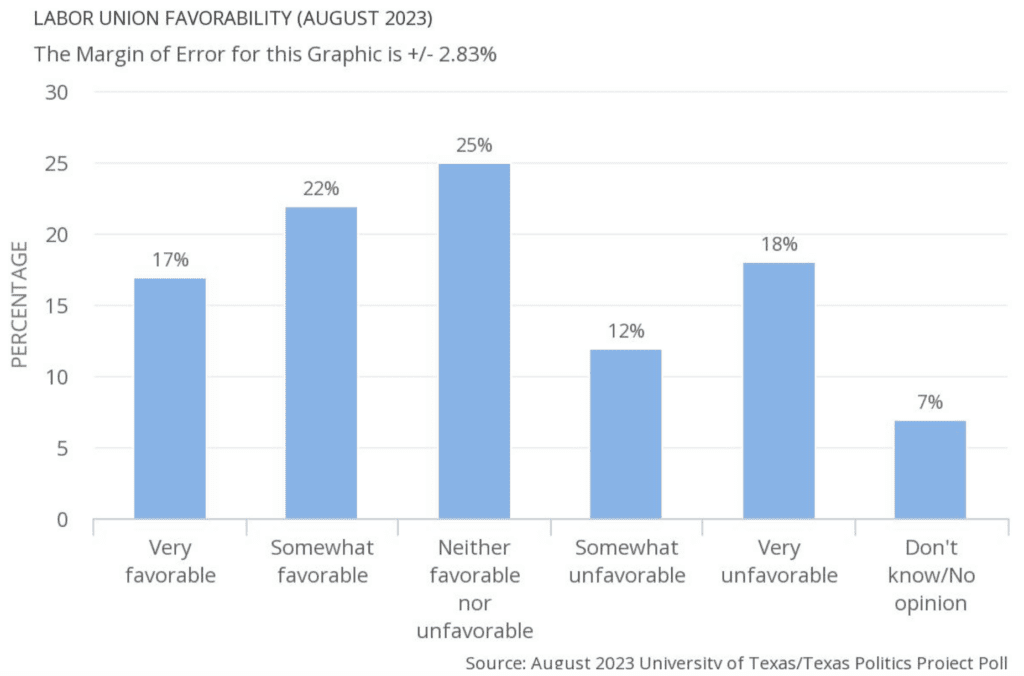
Similar to the national data, younger Texans under the age of 29 show substantially higher “very union favorable” rates than the older age groups, while Texans 65 years and older have the highest unfavorability rate.

How to start or join a union
Joining or starting a union in your own workplace is one of the best ways to raise labor standards for everyone involved while increasing your engagement in a growing labor movement. The process for starting a union is similar across industries. The American Federation of Labor and Congress of Industrial Organizations (AFL-CIO) is a great resource and offers guidance on starting a union. Start by learning about the Texas state federation and Central Labor Council, and check out the Department of Labor’s Worker Organizing Knowledge and Resource Center for answers to your union organizing questions.
Unions benefit every worker across diverse sectors and fields of work. Every Texan’s staff started a union in November 2020. As a proud unionized workplace, Every Texan ratified our first Collective Bargaining Agreement (CBA) with Every Texan United in August 2021. Some of our CBA advancements include: staff base salary increases from $40,000 to $56,500,16 weeks of paid parental leave, 12 weeks of family medical leave, a 7% no-employee required match SEP IRA contribution, and a $200 monthly student loan stipend. Every Texan and Every Texan United collaborate in the workplace through a Labor Management Committee.
Be in solidarity with union members.
Today, wealth grows for a select few while the rest of us struggle to make ends meet. Wealthy elite rig the rules to redirect resources from our communities into their pockets, and try to divide us based on our skin color, faith, or who we love. But when people come together across race, place, gender, and background, we all do better – that’s the solidarity dividend.
Here are a few ways you can show up:
- Don’t cross a picket line. Join it.
- Sign the UAW petition to show your support for workers.
- Buy union-made goods.
- Interested in learning more about Texas and unions? Check out our worker power campaign and sign up for advocacy alerts.
